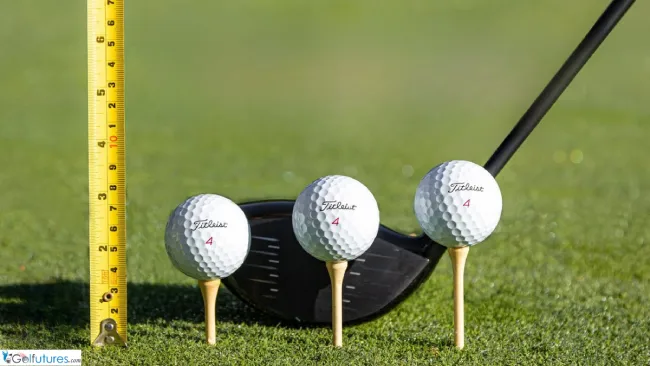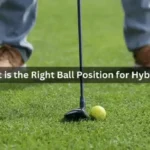Finding the right tee height for your driver is key to improving your game. The height of your ball affects how far and straight you can hit it. By understanding how tee height impacts your swing, you can adjust to play better.
This guide will explore the importance of tee height. We’ll look at how it fits with your swing and the course. Whether you’re a pro or amateur, knowing how to choose the best tee height will boost your game.
How Tee Height Affects Launch Angle
The tee height directly affects the launch angle of your golf ball. A higher tee position leads to a higher launch angle, as the driver’s club face hits the ball more upward.
On the other hand, a lower tee height results in a lower launch angle. This can be good for getting more distance on certain courses.
The Relationship Between Tee Height and Ball Spin
The ball spin rate is closely linked to launch angle. Higher tee heights usually mean more backspin, while lower tee positions can lower overall spin. Knowing this is key, as the right spin rates help control ball trajectory and achieve the shot shape you want.
Impact on Club Face Contact
The club face contact point is also influenced by tee height. Adjusting the tee height correctly ensures consistent, centered contact between the driver and the ball. This leads to better energy transfer, improving distance and accuracy.
What is the Perfect Tee Height for Driver?
Finding the ideal tee height for your driver is essential for improving both distance and accuracy off the tee. By experimenting with different heights, you can discover the setup that optimizes your launch angle, spin rate, and overall performance.
Here’s a breakdown of the key points to help you find the perfect tee height:
Standard Tee Height Guideline
A commonly recommended starting point for driver tee height is to position the ball so that the top of the driver’s clubface aligns with or is slightly above the top of the ball. This setup generally allows for solid contact at the optimal spot on the ball, just above its equator, which helps achieve a good launch angle and spin rate—both crucial for long, accurate drives.


Standard Tee Height
Experimenting to Find Your Optimal Height

While the standard guideline is a good baseline, personal swing characteristics can influence what works best for you. Many golfers find that experimenting with tee heights ranging from 1 to 3 inches can help them determine what feels and performs best.
- A lower tee height can lead to a lower launch angle and increased spin, while a higher tee height tends to promote a higher launch and reduced spin.
- Adjustments to the tee height can also impact your ability to consistently hit the ball on the driver’s sweet spot, which is essential for maximizing ball speed, carry, and total distance.
Key Factors to Consider
To find your personal best tee height, consider the following:
Driver Loft:
Drivers with higher lofts (10–12 degrees) typically perform well with a tee height around 2.5–3 inches, whereas lower lofted drivers (8–9 degrees) may benefit from a height closer to 3–3.5 inches.
Ball Position:
Placing the ball forward in your stance, near the inside of your lead foot, encourages better contact and helps you strike the sweet spot on the clubface.
Club Face Angle:
Tee height can subtly affect the clubface angle at impact. A higher tee may result in a slightly open face, while a lower tee could make the face more closed. Experimenting with these adjustments can lead to your preferred ball flight.
Practical Measurement Tips

For ease and consistency, you can use quick measurement methods:
- Use a tee height ruler or measuring tool designed for golf.
- Alternatively, measure the distance from the ground to the top of the tee with your driver at address, then test how this height affects your ball flight and distance.
Track Your Results
Observe changes in your performance as you experiment with tee height. Track factors like ball speed, launch angle, carry distance, and overall distance to identify any improvements.
Signs You’re Using the Wrong Tee Height

Many golfers face challenges in finding the right tee height, leading to problems on the course. We’ll look at signs you might be using the wrong tee height and how to spot them.
Ball Flight Indicators
One clear sign of the wrong tee height is how the ball flies. If your drives often go low and weak or balloon too much, your tee height might be off. Watching how your shots start and fly can help you figure out if your tee height is right.
Impact Position Problems
Another sign is where your driver hits the ball. If you hit it high on the clubface or struggle to hit it solidly, your tee height might need tweaking. The right height ensures solid, centered hits for better distance and control.
Distance Loss Symptoms
Finally, a big drop in your driving distance or distance consistency hints at a tee height issue. The wrong height can mess with how the ball launches, its speed, and your overall game. This can cut down your distance and accuracy.
Keep an eye on how the ball flies, where it’s hit, and your distance. These signs can tell you if your tee height is causing golf swing issues, tee height problems, and driving performance problems. Knowing this, you can adjust your tee height for better results.
How Different Driver Types Affect Optimal Tee Height
The type of driver you use can greatly affect the best tee height for you. The loft, clubhead design, and adjustable features all matter. They help find the perfect tee spot for the best results.
| Driver Type | Recommended Tee Height |
| High Loft (10-12°) | Slightly Higher |
| Low Loft (8-9°) | Slightly Lower |
| Large, Forgiving Clubhead | Slightly Higher |
| Compact Clubhead | Slightly Lower |
| Adjustable Driver | Experiment with Different Heights |
Breakdown Explanation of Each Driver
- High Loft (10-12°): Drivers with higher lofts tend to perform best with a slightly higher tee height. This setup helps the ball fly higher and straighter, providing better launch conditions.
- Low Loft (8-9°): Lower lofted drivers perform better with a slightly lower tee height. This helps with controlling the ball’s spin and achieving a more controlled launch angle.
- Large, Forgiving Clubhead: Drivers with larger, more forgiving clubheads often require a slightly higher tee. The larger clubhead helps with getting the ball airborne easily, especially for golfers who may have a less consistent strike.
- Compact Clubhead: Smaller, more compact clubheads often work best with a slightly lower tee height. This allows for better control of the ball’s path and spin.
- Adjustable Driver: For adjustable drivers with movable weights or loft sleeves, it’s best to experiment with different tee heights. The adjustable nature of the club allows for personalized fine-tuning to optimize performance.
Adjusting Tee Height for Different Weather Conditions
As a golfer, you know weather affects your game a lot. Wind and rain change how you should set your tee height. Adjusting it helps keep your driving consistent and improves your game.
| Weather Condition | Recommended Tee Height Adjustment |
| Windy Conditions | Lower tee height slightly |
| Wet Conditions | Increase tee height |
Pay attention to the weather and adjust your tee height accordingly. This optimizes your driver performance, especially in windy and wet conditions. Finding the perfect tee height takes practice, so be patient and keep trying.
FAQS
Q: How can tee height affect my driving distance and accuracy?
A: Tee height impacts both distance and accuracy by changing your angle of attack. A higher tee height encourages an upward strike, increasing distance by launching the ball higher with less spin. However, Teeing too high can reduce accuracy.
On the other hand, lower tee heights help with control, especially in windy conditions, by keeping the ball flight lower and more stable.
Q: Why do I keep hitting the ball too low or popping it up?
A: Hitting too low often means your tee is set too low, causing you to sweep the ball or hit it on the downswing. Popping it up usually means the tee is too high. You can adjust your tee height and focus on hitting with a slightly upward angle to find a consistent strike.
Q: How can I find my perfect driver tee height?
A: Start with half the ball above the driver and adjust up or down slightly. Notice which height gives you the best mix of distance and control, and aim to replicate this height in your rounds.
Q: What is the relationship between tee height and club face contact?
A: Your tee height impacts how your driver’s clubface meets the ball. The right height ensures better contact, leading to more consistent and powerful drives.
Q: What are some advanced techniques for optimizing my tee height?
A: Pros often try different tee heights to improve their drive. They might use high-speed cameras, launch monitors, or other tools to analyze their game. By experimenting and analyzing, you can find the perfect tee height for your game.







